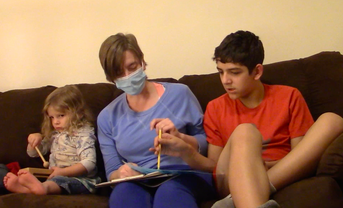|
Remember back to when you first started RPM. -Did you think it was too good to be true? -Did it seem your student/child would never spell open ended thoughts for you? -Did you think your student/child was too “low functioning” to even understand? -Were you exhausted and doubtful? OR -Did you feel you finally found a method that brought out your child’s intelligence in a way you knew was there all along? Perhaps you experienced a combination of these and many more emotions No matter which way, RPM most likely has you stretching yourself in ways you didn’t know you’d have to stretch.  If you haven’t got your student/child to open communication yet, just keep problem solving and working at it. It comes. The following is something to look forward to although probably not the top priority right now. For those of you who have your student/child spelling open ended thought some goals to consider: -being able to spell sentences and paragraphs more fluently—all types of thoughts: persuasive writing, stories, academic content, journals, thoughts about an issue, etc -make sure the letterboard is held still -continue to eliminate as much potential inadvertent influence as possible. This can be influence from technique that needs improvement or emotional influence. While the following can help with the task listed above, (so in some cases you might incorporate a bit of these to help grow those skills and help them progress) these often are most successful when the student is more fluent with those. You might try: -handwriting -spelling with the student holding his/her own board -spelling with the letterboard flat on the table -spelling on a keyboard or iPad. -speech These skills start with teach/ask so you can increase and appropriately prompt and then slowly fade prompts with proficiency and increase types of responses to one word, sentence, paragraph in these skills/mediums. Additionally, think back to when you first started RPM. It is time to stretch again and without wearing yourself out, continue to believe in the development of the student’s hobbies, self-help, community contributions in ways you may not of thought possible. Ideas (some are more appropriate at different ages) to work on: -self help skills—toilet training, dressing him/herself, hygiene -navigate their environment: selecting books and items to use or give to another -developing visual tolerance and reading independently -play an instruments -composing music -art-like drawing and painting -crafts: sewing, gluing, wood work, etc -start a small business -writing plays, books, etc -grow sensory tolerance to more activities, situations and people allowing a student to function and move forward in life Use RPM strategies to build these skills. It make take you time as a parent/teacher to figure out how to apply the technique to these skills, but keep at it and eventually it becomes more natural. Continue to set education, communication, tolerance and skill goals, to allow the student to function as independently as possible and be the best he/she can be. There are a lot of possibilities and tons of potential. Pace yourself but continue to seeks ways for your student to have a quality of life. Do your best to view this all as an exciting journey that will be successful-- We have no idea what these students can do! Here are some resources to help you with progressing in the areas listed above that you may find useful. Click on the picture to be taken to Amazon to purchase: For more information abut the Music or Art book click HERE FOR MUSIC and HERE FOR ART.
For skill building videos, click HERE.
0 Comments
Leave a Reply. |
AuthorWrite something about yourself. No need to be fancy, just an overview. ArchivesCategories |










 RSS Feed
RSS Feed
